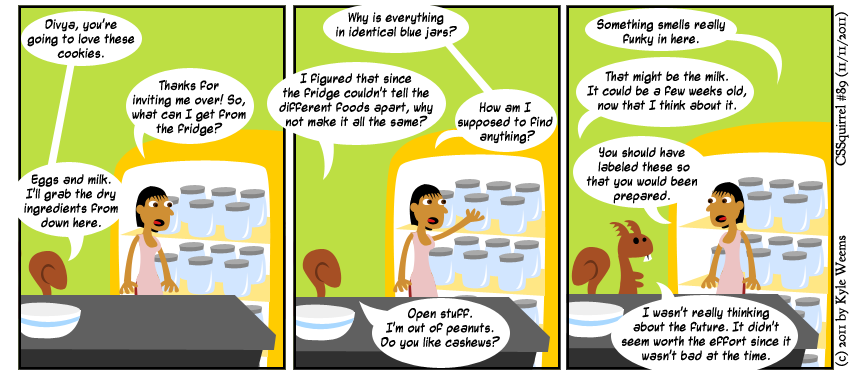Disembodied
Monday, September 10th, 2012
John Foliot reprises the role of the Scarecrow and Matt May takes a turn in the role of the Wizard in today’s Ozian look at the HTML5 Issue of the Week, and represents the frustration I’m sure accessibility experts face every damn day when trying to deal with the nonsense that is getting people to adopt proper accessibility support in the web.
Today we’re looking at ARIA’s role (no pun intended) in HTML5. More accurately, whether ARIA would have a role in HTML5. Now, typically my posts about idiocy involving HTML specs tend to involve Hixie and the WHATWG. This time, sadly, I’m discussing the W3C, and specifically actions of the co-chairs of their HTML WG.
And here I thought we were besties.
I’ll recap:
For entirely too long now the W3C has been debating whether or not to include the longdesc attribute in HTML5. This debate, which has been pretty rancorous since at least 2008 (jinkies!) is known as Issue-30. Longdesc is an attribute that you can attach to an image tag to inform capable devices of looking to a specific URL for a longer description of the image for the visually impaired. We’re not talking about a simple alt tag of “girl under tree” for every college campus in the world. We’re talking about a genuine effort to impart the information about an image to a viewer who can’t properly see the image, if at all.
Here at CSSquirrel I use the longdesc attribute to link to the transcripts for the comics.
To me, this is a big deal. I have blind readers, many of which want to enjoy the comic that the sighted readers can see. I’ve received numerous requests in the past to put transcripts up, so I’ve built the site to serve that need. Is it a sizable percentage of my readership? No. Does that matter? No! If we’re letting lazy implementation of available solutions get in the way of us helping one visitor with accessibility needs, then what does that say about us as people?
During a standoff between the W3C groups responsible for HTML and ARIA, Sam Ruby (Co-Chair of the HTML WG) suggested that the entirety of ARIA be removed from the HTML5 spec until sometime in the future when Issue-30 could be amicably resolved. This is absurd! It’s like throwing the baby out with the bathwater!
There is a lot of ARIA that is seeing author implementation in HTML right now, most notably ARIA roles. Their inclusion provide real assistance for visitors with accessibility issues in navigating and understanding the content of a website, and in some cases provide extra helpers for non-human agents to crawl the content as well. (I’ve even used them as clever hooks for tricky bits of CSS).
A debate ensued.
Well, re-ensued.
At one point, John Foliot dropped in with a detailed examination of statements being made by the HTML Co-Chairs about the situation, correcting falsehoods and reinforcing how important this issue is. This is a man who’s spent years as an accessibility expert watching bureaucratic process and non-expert interference getting in the way of providing solutions to genuine accessibility needs. He gets direct and to the point, as time and again it’s been proven over and over that anything short of that will fail to sink in.
Their detailed response to the situation thus far?
A slap on John’s wrist for his tone.
It’s been a few days since, and that’s as far as it has gone.
I’m sorry blind folks. The bad man’s mean tendency to call them out when they’re being bureaucratically false while defending their indefensible suggestion of removing major accessibility support from HTML5 is more important than your ability to use the 21st century’s most important communication medium.
But that’s OK, I’m sure your seeing-eye dog can navigate websites for you, right?
Steve Faulkner recently tweeted the following to me on the topic (good man, fights hard, really should be put in one of my comics ASAP): “I think the suggestion to move ARIA out of HTML5 was misguided tactic of the chairs to force progress on an issue. - won’t happen“
I appreciate that Issue-30, which has gone unresolved for years, is annoying. But threatening to pull out the entirety of ARIA from HTML5 in some sort of chicken head-on-collision maneuver is a new low in the entire HTML5 spec authoring process.
And that is saying a lot.
Are you an accessibility expert or a web developer that uses ARIA? Are you a person with an opinion about longdesc or ARIA roles? What do you think of this whole mess? What suggestions do you have for the W3C to get this mess fixed? Did I get something wrong? Please help educate me by responding via one of the methods below?

